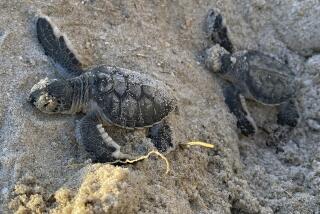Satellites Track Endangered Sea Turtles on the Brink : Florida: They hatch, scurry into the Atlantic and swim off to spend the next three decades, but where? Scientists want to identify the feeding grounds and learn a great deal more about the endangered creatures.
- Share via
ORLANDO, Fla. — It is one of nature’s enduring mysteries: Where do the Atlantic green sea turtles spend their lives?
The turtles begin life as 2-inch-long hatchlings on Florida’s subtropical beaches. They scurry through the sand to the sea and are off.
Over the next three decades, the turtles grow into 300-pound plus creatures, traveling thousands of miles to feed and nest.
Because little is known about where they go, scientists have equipped three adult turtles with satellite transmitters in hopes of solving the mystery.
The transmitters will track the turtles’ movements via signals beamed up to orbiting Argos satellites. The satellites retransmit the signals to a receiving station in Paris, where they are decoded and sent to researchers in Florida.
Florida is the most important sea turtle nesting area in the United States, and the endangered Atlantic green turtle is of particular concern to federal and state agencies, as well as environmentalists.
“Most people don’t realize that 90% of sea turtle nesting occurs in Florida, and the protection and conservation activities here have a major impact around the world,” said David Godfrey, director of the Sea Turtle Survival League, based in Gainesville.
Estimates of Florida’s annual green turtle nesting population vary, but the latest is about 500. This comes from data collected in the mid-1980s and does not take into account increases believed to have occurred since as a result of protective legislation and educational programs.
In November, state voters approved a ban on most net fishing in state waters, in part to protect the air-breathing reptiles that sometimes get caught in fishing nets and drown.
As part of their efforts to better protect the turtles, scientists want to identify the feeding grounds where they spend most of their lives.
They also hope to learn what routes the turtles take to get to their summer nesting grounds on subtropical beaches in Florida and elsewhere.
Scientists know that after each Florida nesting season, the turtles migrate to distant locations rich in sea-grass or algae beds. Likely destinations are the Bahamas, Nicaragua, Honduras and the Caribbean islands.
Sea turtles have few natural enemies but face many man-made threats, including poachers, loss of habitat, pollution, and the encroachment of man.
The sea turtle doesn’t mature until it is 12 to 15 years old, about midway through its life. The female then lumbers to shore each summer to deposit hundreds of thousands of eggs.
Many of the newborn die before making it to the water. They can be washed away, eaten by birds or other predators, or get disoriented by beachside lighting during their mad dash to the sea.
“Until we know where they’re foraging most of the year, we can’t adequately protect all the habitats used by Florida green turtles,” said Llew Ehrhart, a University of Central Florida biologist.
Ehrhart is one of the principal researchers in the satellite “tagging” project being carried out by the university, the Marine Research Institute of Florida’s Department of Environmental Protection and the National Marine Fisheries Service.
Researchers attached the small Walkman-sized transmitters last July to the backs of the three female green turtles that nested in the 20-mile-long Archie Carr National Wildlife Refuge along Florida’s East Coast.
The turtles are being monitored daily, and researchers hope the satellite signals will give away their final destinations.
Sea turtles must be protected in every location where they spend their lives--not just in Florida, Godfrey said.
“As research reveals more about where the turtles spend the various stages of their life cycle, our efforts to protect them can focus on those areas,” he said.
More to Read
Sign up for Essential California
The most important California stories and recommendations in your inbox every morning.
You may occasionally receive promotional content from the Los Angeles Times.













